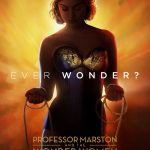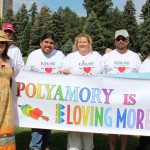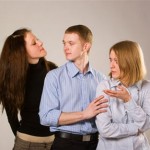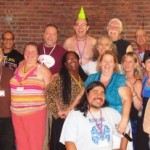Sex at Dawn: The Prehistoric Origins of Modern Sexuality written by Christopher Ryan, PhD and Cacilda Jethà, PhD
Harper. 2010

I am a sex educator and have been teaching college students and adults what I have learned about Human Sexuality for many years. This book has caused me to look seriously at what I believed was factual about my favorite subject and question some of the received wisdom of my text books and mentors. I think this book is a “MUST READ” for every sexuality educator, therapist, researcher and anyone else seriously interested in the subject.
I have had many questions about evolutionary psychology since I personally don’t seem to fit into the model. Nor do many of the people I see around me. Monogamy does not seem to be built into our behavior, but forced upon us by our culture and religion. High divorce rates, cheating scandals like Tiger Woods and Jesse James seem more like the norm. The gay marriage issue is difficult to understand in a standard evolutionary perspective. Did my genes really want me to find a partner of the other sex based on “mate value” and stay with her for the rest of my life, forsaking all others until death does us part? It didn’t work for me.
Ryan and Jethà question almost everything I have been taught about evolutionary psychology. They begin by defining the “standard narrative of human sexual evolution” which is roughly: boy meets girl, they evaluate each other’s mate value based on their differing reproductive agendas (youth and fertility is his measure, wealth and status for her), they mate and form a long-term pair bond. She watches for any sign he might leave her (intimacy with other women) and he watches for any sign of sexual infidelity (lack of paternity certainty). Instead of seeing these as elements of human nature, the authors suggest they are adaptations to social conditions. They then link this to the development of agriculture about 10,000 years ago, about 5% of the existence of the modern human. Prior to that time we lived in “immediate-return hunter-gatherer” communities, small numbers of people on a very large and fruitful earth. Those few of these societies that still exist today are fiercely egalitarian, sharing everything.
They look at the work of the major writers on the human historical record, anthropologists and archeologists and,  particularly, evolutionary psychologists, and point out their assumptions. For example, I have been taught, and have taught, that marriage is found in over 140 different cultures and societies. What is the definition of “marriage” being used in these studies? How long do they last, how hard are they to end, what meaning do these cultures apply to what the outside observer sees? Is it marriage, or is it pair bonding, or just sexual behavior they are seeing? Are the scientists trying to fit what they see into what they think “should be” and not letting the information speak for itself? And in any case, what does this say about pre-agricultural societies in the 200,000 years of anatomically modern humans; read Chapter 8, “Making a Mess or Marriage, Mating and Monogamy” for some insight into this problem.
particularly, evolutionary psychologists, and point out their assumptions. For example, I have been taught, and have taught, that marriage is found in over 140 different cultures and societies. What is the definition of “marriage” being used in these studies? How long do they last, how hard are they to end, what meaning do these cultures apply to what the outside observer sees? Is it marriage, or is it pair bonding, or just sexual behavior they are seeing? Are the scientists trying to fit what they see into what they think “should be” and not letting the information speak for itself? And in any case, what does this say about pre-agricultural societies in the 200,000 years of anatomically modern humans; read Chapter 8, “Making a Mess or Marriage, Mating and Monogamy” for some insight into this problem.
The authors write at length, and with humor, about the genetic connection to our nearest primate cousins, and question why the chimpanzee is considered the model for human history and not the Bonobo. Is it because modern day man is at war over scarce resources and the Bonobo just wants to have sex and eat. How could THAT be our ancestor?
 “No animal spends more of its allotted time on Earth fussing over sex than Homo sapiens – not even the famously libidinous Bonobo. Although we and the Bonobo both average well into the hundreds, if not thousands, of acts of intercourse per birth – way ahead of any other primate – their “acts” are far briefer than ours. Pair-bonded “monogamous” animals are almost always hyposexual, having sex as the Vatican recommends: infrequently, quietly, and for reproduction only. Human beings, regardless of religion, are at the other end of the libidinal spectrum: hypersexuality personified” (p. 85)
“No animal spends more of its allotted time on Earth fussing over sex than Homo sapiens – not even the famously libidinous Bonobo. Although we and the Bonobo both average well into the hundreds, if not thousands, of acts of intercourse per birth – way ahead of any other primate – their “acts” are far briefer than ours. Pair-bonded “monogamous” animals are almost always hyposexual, having sex as the Vatican recommends: infrequently, quietly, and for reproduction only. Human beings, regardless of religion, are at the other end of the libidinal spectrum: hypersexuality personified” (p. 85)
This book is educational, widely entertaining, often humorous, and helps explain why we humans behave as strangely as we often do. I cannot begin to cover what the authors cover in 312 pages of text, 35 pages of endnotes and 31 pages of references. I can only encourage you to buy this book, mark up the interesting parts, review their endnotes and references, and decide for yourself if what you teach is really factual, or socially conditioned cultural beliefs. I suspect you might change your lecture notes, I have.
David Hall, Ph.D.
David is a sexuality educator. Treasurer of the Society for the Scientific Study of Sexuality, Western Region. Managed the regional office, have chaired five regional conferences. Received the “Distinguished Service to SSSS” Award in 1998 and is the currently elected President of the Western Region.








I subscribe to e-newsletters from three attraction-tech gurus only because every so often they say something amusing. These hucksters generally subscribe to the usual watered-down quasi-pop-Darwinianism that latter-day “evo-psycho” presumes. I sent the excerpt page of Sex At Dawn’s twebsite o my three gurus towards their enlightenment. I also posted several qoutes on my Facebook wall.